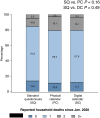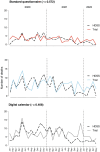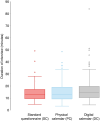Improving retrospective data on recent household deaths: a multi-arm randomized trial in Guinea-Bissau
- PMID: 39993265
- PMCID: PMC11849960
- DOI: 10.1093/ije/dyaf009
Improving retrospective data on recent household deaths: a multi-arm randomized trial in Guinea-Bissau
Abstract
Background: In countries with limited civil registration and vital statistics systems, assessing the impact of health crises requires precise retrospective mortality data. We tested whether calendar methods improve survey or census data on dates of recent household deaths registered in a Health and Demographic Surveillance System (HDSS).
Methods: Between April and June 2023, we randomized 578 households with HDSS-registered deaths in Guinea-Bissau to interviews by using (i) a standard questionnaire with close-ended questions about dates of deaths, or similar questionnaires supplemented with (ii) a physical calendar of local events printed on paper or (iii) a digital calendar implemented on tablets. We evaluated the accuracy of reported dates through record linkages to HDSS data.
Results: No deaths were reported in 11.8% of the 508 participating households. In other households (n = 448), informants reported 574 deaths since January 2020. Relative to the standard questionnaire, neither the physical calendar nor the digital calendar improved the proportion of deaths reported in the same month and year as recorded by using surveillance data. The physical and digital calendars reduced the share of missing data on dates of deaths (6.1% and 3.2%, respectively, versus 13.1% with the standard questionnaire). Reported dates of deaths obtained by using the digital calendar were more weakly correlated with surveillance data than those collected in other arms. Using the digital calendar also added 1.15 minutes to the data collection.
Conclusion: Digital calendars do not improve the reporting of dates of deaths in surveys or censuses. Further trials of the use of a physical calendar in retrospective interviews about recent household deaths are warranted.
Keywords: Bandim Health Project; Guinea-Bissau; civil registration and vital statistics; data quality; low- and lower-middle-income countries; mortality; randomized trial; recall; survey.
© The Author(s) 2025. Published by Oxford University Press on behalf of the International Epidemiological Association.
Conflict of interest statement
None declared.
Figures







Similar articles
-
Provider-mother interactions are associated with birth outcome misclassifications in household surveys: A case-control study in Guinea-Bissau.J Glob Health. 2023 Aug 18;13:04086. doi: 10.7189/jogh.13.04086. J Glob Health. 2023. PMID: 37590896 Free PMC article.
-
Comparing performance of methods used to identify pregnant women, pregnancy outcomes, and child mortality in the Iganga-Mayuge Health and Demographic Surveillance Site, Uganda.Glob Health Action. 2017;10(1):1356641. doi: 10.1080/16549716.2017.1356641. Glob Health Action. 2017. PMID: 28799450 Free PMC article.
-
"Every Newborn-INDEPTH" (EN-INDEPTH) study protocol for a randomised comparison of household survey modules for measuring stillbirths and neonatal deaths in five Health and Demographic Surveillance sites.J Glob Health. 2019 Jun;9(1):010901. doi: 10.7189/jogh.09.010901. J Glob Health. 2019. PMID: 30820319 Free PMC article.
-
Characteristics, availability and uses of vital registration and other mortality data sources in post-democracy South Africa.Glob Health Action. 2012 Dec 27;5:1-19. doi: 10.3402/gha.v5i0.19263. Glob Health Action. 2012. PMID: 23273252 Free PMC article. Review.
-
The impact of AIDS on adult mortality: evidence from national and regional statistics.AIDS. 2004 Jun;18 Suppl 2:S19-26. doi: 10.1097/00002030-200406002-00003. AIDS. 2004. PMID: 15319740 Review.
References
-
- Mikkelsen L, Phillips DE, AbouZahr C et al. A global assessment of civil registration and vital statistics systems: monitoring data quality and progress. Lancet 2015;386:1395–406. - PubMed
-
- Setel PW, Macfarlane SB, Szreter S et al.; Monitoring of Vital Events. A scandal of invisibility: making everyone count by counting everyone. Lancet 2007;370:1569–77. - PubMed
Publication types
MeSH terms
Grants and funding
LinkOut - more resources
Full Text Sources
Miscellaneous

